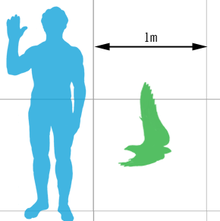- Sapeornis
-
Sapeornis
Temporal range: Early Cretaceous, 120 MaFossil displayed in Hong Kong Science Museum Scientific classification 
Kingdom: Animalia Phylum: Chordata Class: Aves Order: †Omnivoropterygiformes Family: †Omnivoropterygidae Genus: †Sapeornis
Zhou & Zhang, 2002Species - S. chaoyangensis Zhou & Zhang, 2002 (type)
- S. angustis Zhou & Zhang, 2009
Synonyms - Omnivoropteryx? Czerkas & Ji, 2002
- Didactylornis Yuan, 2008
- Shenshiornis? Hu et al., 2010
Sapeornis is a genus of primitive bird which lived during the Early Cretaceous (late Aptian to early Albian, roughly 120-110 mya). The genus contains only the species Sapeornis chaoyangensis which is known from fossils found in Jiufotang Formation rocks near Chaoyang, PRC. Several nearly complete skeletons have been found.[1]
Sapeornis is named for SAPE, the Society of Avian Paleontology and Evolution, added to the Ancient Greek όρνις (ornis), meaning "bird". chaoyangensis is Latin for "from Chaoyang".
Contents
Description
This animal was about 30–33 cm long in life, excluding the tail feathers (which are unknown). From its general morphology and some peculiar similarities with oviraptorosaurs such as Caudipteryx, it is usually considered to be fairly close to Omnivoropteryx.[2]
The hand of Sapeornis was far more advanced than that of Archaeopteryx. It had three fingers, the outer ones with two and the middle one with three phalanges, and a well-fused carpometacarpus. Its arms were about half again as long as the legs, suggesting a large wing area. On the other hand, its shoulder girdle was apparently ill-adapted to flapping flight and its furcula was unusual, with the hypocleidum of more advanced birds but a general conformation even more primitive than in Archaeopteryx.[3] The humerus was large and bore holes, apparently to save weight, as in the Confuciusornithidae.
The skull has a handful of teeth in the upper jawtip only. It was altogether similar to Archaeopteryx, but even more so to small oviraptorosaurs and Omnivoropteryx.[4] Sapeornis had gastralia but no (or unossified) uncinate processes. A sternum was either not present or small and easily lost. The pygostyle was rod-like as in Confuciusornis and Nomingia, but like in the former there was no long bony tail anymore. While the tarsometatarsi were more fused than in Archaeopteryx, the fibula was long and reached the distal point of the tarsal joint, not reduced as in more modern birds (and some non-avian theropods like Avimimus). The first toe pointed backwards. In specimen IVPP V12375, the stomach contained numerous small gastroliths. Analysis of its skeletal bones suggest that it had an ontogeny and slow growth like Archaeopteryx and small carnivorous dinosaurs, rather than the explosively fast growth seen in living birds.[5]
In absolute number of features shared with modern birds, S. chaoyangensis is about as advanced as Confuciusornis. However, the apomorphies were largely different from Confuciusornis, and a character analysis demonstrates that these two were not closely related.[6] As its plumage is not known yet, the airfoil shape of Sapeornis is unknown. As indicated by the slender pygostyle, its tail plumage was probably short as in the Enantiornithes and Confuciusornis, with at most two to four long tail feathers. The reduced fingers suggest that it might have had an alula. Not being well-adapted to flapping flight, Sapeornis probably was a glider and/or soarer that preferred more open country compared to the Enantiornithes and other predominantly woodland birds, although it was able to perch on branches. The small gastroliths, overall large size, and the inferred habitat indicate that Sapeornis was most likely a herbivore, possibly eating plant seeds and fruits.[1]
Comparisons between the scleral rings of Sapeornis and modern birds and reptiles indicate that it may have been diurnal, similar to most modern birds.[7]
Classification and species
In 2008, Yuan named a new specimen related to Sapeornis as Didactylornis jii. Yuan concluded that Didactylornis differed from Sapeornis in the proportions of the foot and number of wing and foot bones.[8] However, the relevant portions of the specimen were badly crushed, and later authors concluded that these differences were based on misinterpretation of the poorly preserved specimen. In a 2010 survey of Chinese fossil birds, Li and colleagues considered Didactylornis a synonym of Sapeornis chaoyangensis.[9] Omnivoropteryx and Shenshiornis are also likely synonymous with Sapeornis.[10]
References
- ^ a b Zhou, Zhonghe & Zhang, Fucheng (2003): Anatomy of the primitive bird Sapeornis chaoyangensis from the Early Cretaceous of Liaoning, China. Canadian Journal of Earth Sciences 40(5): 731–747. doi:10.1139/E03-011 (HTML abstract)
- ^ Czerkas, S. A. & Ji, Q. (2002): A preliminary report on an omnivorous volant bird from northeast China. In: Czerkas, S. J. (editor): Feathered Dinosaurs and the origin of flight. The Dinosaur Museum Journal 1: 127-135. HTML abstract
- ^ Senter, Phil (2006): Scapular orientation in theropods and basal birds, and the origin of flapping flight. Acta Palaeontologica Polonica 51(2): 305–313. PDF fulltext
- ^ Sapeornis chaoyangensis skull reconstruction
- ^ Erickson, Gregory M.; Rauhut, Oliver W. M., Zhou, Zhonghe, Turner, Alan H, Inouye, Brian D. Hu, Dongyu, Norell, Mark A. (2009). "Was Dinosaurian Physiology Inherited by Birds? Reconciling Slow Growth in Archaeopteryx". PLoS One.
- ^ Zhou, Zhonghe & Zhang, Fucheng (2006): A beaked basal ornithurine bird (Aves, Ornithurae) from the Lower Cretaceous of China. Zool. Scripta 35: 363–373. doi:10.1111/j.1463-6409.2006.00234.x (HTML abstract)
- ^ Schmitz, L.; Motani, R. (2011). "Nocturnality in Dinosaurs Inferred from Scleral Ring and Orbit Morphology". Science in press. doi:10.1126/science.1200043. PMID 21493820.
- ^ Yuan, C. (2008). "A new genus and species of Sapeornithidae from Lower Cretaceous in western Liaoning, China". Acta Geologica Sinica 82 (1): 48–55. doi:10.1111/j.1755-6724.2008.tb00323.x.
- ^ Li, D., Sulliven, C., Zhou, Z. and Zhang, Z. (2010). "Basal birds from China: a brief review." Chinese Birds, 1(2): 83-96 doi:10.5122/cbirds.2010.0002
- ^ Holtz, Thomas R. Jr. (2011) Dinosaurs: The Most Complete, Up-to-Date Encyclopedia for Dinosaur Lovers of All Ages, Winter 2010 Appendix.
External links
Categories:- Cretaceous birds
- Genera of birds
- Omnivoropterygidae
Wikimedia Foundation. 2010.


